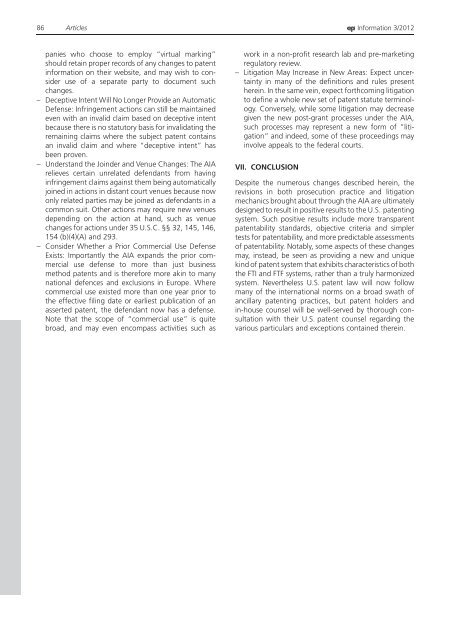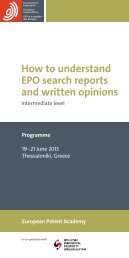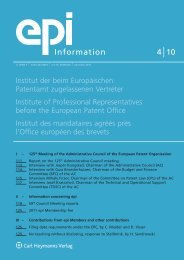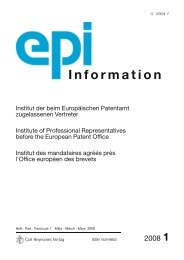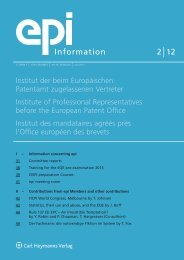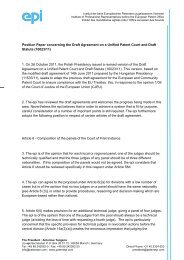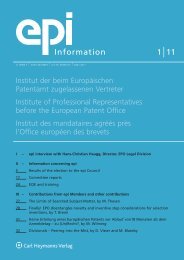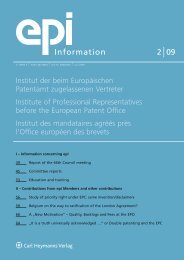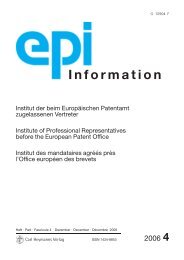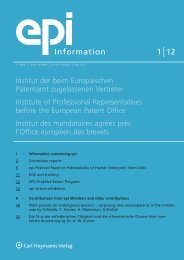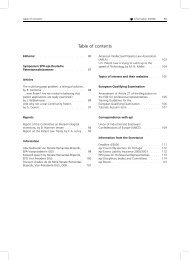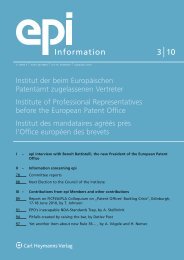Create successful ePaper yourself
Turn your PDF publications into a flip-book with our unique Google optimized e-Paper software.
86 Articles Information 3/2012<br />
panies who choose to employ “virtual marking”<br />
should retain proper records of any changes to patent<br />
information on their website, and may wish to consider<br />
use of a separate party to document such<br />
changes.<br />
– Deceptive Intent Will No Longer Provide an Automatic<br />
Defense: Infringement actions can still be maintained<br />
even with an invalid claim based on deceptive intent<br />
because there is no statutory basis for invalidating the<br />
remaining claims where the subject patent contains<br />
an invalid claim and where “deceptive intent” has<br />
been proven.<br />
– Understand the Joinder and Venue Changes: The AIA<br />
relieves certain unrelated defendants from having<br />
infringement claims against them being automatically<br />
joined in actions in distant court venues because now<br />
only related parties may be joined as defendants in a<br />
common suit. Other actions may require new venues<br />
depending on the action at hand, such as venue<br />
changes for actions under 35 U.S.C. §§ 32, 145, 146,<br />
154 (b)(4)(A) and 293.<br />
– Consider Whether a Prior Commercial Use Defense<br />
Exists: Importantly the AIA expands the prior commercial<br />
use defense to more than just business<br />
method patents and is therefore more akin to many<br />
national defences and exclusions in Europe. Where<br />
commercial use existed more than one year prior to<br />
the effective filing date or earliest publication of an<br />
asserted patent, the defendant now has a defense.<br />
Note that the scope of “commercial use” is quite<br />
broad, and may even encompass activities such as<br />
work in a non-profit research lab and pre-marketing<br />
regulatory review.<br />
– Litigation May Increase in New Areas: Expect uncertainty<br />
in many of the definitions and rules present<br />
herein. In the same vein, expect forthcoming litigation<br />
to define a whole new set of patent statute terminology.<br />
Conversely, while some litigation may decrease<br />
given the new post-grant processes under the AIA,<br />
such processes may represent a new form of “litigation”<br />
and indeed, some of these proceedings may<br />
involve appeals to the federal courts.<br />
VII. CONCLUSION<br />
Despite the numerous changes described herein, the<br />
revisions in both prosecution practice and litigation<br />
mechanics brought about through the AIA are ultimately<br />
designed to result in positive results to the U.S. patenting<br />
system. Such positive results include more transparent<br />
patentability standards, objective criteria and simpler<br />
tests for patentability, and more predictable assessments<br />
of patentability. Notably, some aspects of these changes<br />
may, instead, be seen as providing a new and unique<br />
kind of patent system that exhibits characteristics of both<br />
the FTI and FTF systems, rather than a truly harmonized<br />
system. Nevertheless U.S. patent law will now follow<br />
many of the international norms on a broad swath of<br />
ancillary patenting practices, but patent holders and<br />
in-house counsel will be well-served by thorough consultation<br />
with their U.S. patent counsel regarding the<br />
various particulars and exceptions contained therein.


